Vatsala Maheshwari1, Richa Chaturvedi2 , Sonali Meshram3 and Rahul Bhalsinge*
1L.N.Medical College and J K Hospital ,Lnct University, Bhopal- 462042
2Department of Pharmacology, Gandhi Medical College,Bhopal-462001.
Corresponding Author E-mail : Rahulbhalsinge@Gmail.Com
DOI : https://dx.doi.org/10.13005/bpj/2196
Abstract
Introduction : Topical steroids are most commonly being used today. Mostly these are being misused due to lack of awareness of their adverse effects. Malpractice and easy availability of these agents also responsible for their abuse. Aim : To Evaluate Topical Steroid abuse in various parameters according to CDSCO ADR forms. Objectives : This study was conducted to know the extent of abuse of topical steroid ,along with clinical profile and mode of accessibility in dermatology department of a teaching institute of tertiary health care centre of central India. Material and Method: First 200 patients of adverse drug reaction attending dermatology department were screened according to ICSR form of CDSCO in a period of December 2015 to November 2016 and 181 patients of them who gave history of topical steroid application were further analyzed. Result: Most commonly affected people belong to age of 21 to 30 years (41.98%),Tinea incognito (58%) was the commonest manifestation of steroid abuse, Tinea (58%)was the most common indication of steroid application, self medication (46.40%) was most common mode of steroid accessibility, betamethasone (61.87%) was most commonly applied topical steroid. Conclusion :Self medication and over the counter drug use were most common mode of steroid accessibility both can be controlled by making strict health regulatory policies . Simultaneously health education program must be targeted to young population who are more vulnerable to steroid abuse to make them aware regarding harmful effects of unguided or misguided use of topical steroid.
Keywords
OTC Drugs; Steroid abuse; Self Medication; Tinea incognito; TSDF
Download this article as:| Copy the following to cite this article: Maheshwari V, Chaturvedi R, Meshram S, Bhalsinge R. Evaluation of Adverse Drug Reactions caused by Topical Steroids in Patients Presenting in Dermatology Department of Teaching Institute of Tertiary Health Care Centre of Central India. Biomed Pharmacol J 2021;14(2). |
| Copy the following to cite this URL: Maheshwari V, Chaturvedi R, Meshram S, Bhalsinge R. Evaluation of Adverse Drug Reactions caused by Topical Steroids in Patients Presenting in Dermatology Department of Teaching Institute of Tertiary Health Care Centre of Central India. Biomed Pharmacol J 2021;14(2). Available from: https://bit.ly/34Zwt1e |
Introduction
Steroids have been in use as topical agents since long time.[1] The topical steroids are being increasingly used since their inception.[2]Topical corticosteroids are among the most commonly prescribed medications in dermatology practice at present[3].Steroid abuse is a common due to easy availability of steroid creams as over-the-counter drugs.[3]Steroids exert – anti-inflammatory, antipruritic, melanopenic, atrophogenic, and immunosuppressive effects on the skin. All these effects can produce adverse effects from their prolonged or unwarranted use.[4] This study was conducted to assess the extent of steroid abuse and the clinical profile of these patients.
Material and Methods
This is a prospective observational study conducted in dermatology department of M.Y.H . hospital ,Indore.200 patients of Adverse drug reactions (ADRs) were screened according to CDSCO,ICSR form. Diagnosis of ADR made by consultant .Out of 200 patients 181 patients were further evaluated who gave history of steroid application topically. Data analysed and result is interpreted in percentage.
Result and Observations
Inference
Majority of cases are from young population. Children & elderly are affected least.(Table I)
Table 1: Age wise distribution of adverse reactions caused by topical steroids.
| Age in years | Number of cases | Percentage(%) |
| <10 | 0 | 0 |
| 11-20 | 52 | 28.72 |
| 21-30 | 76 | 41.98 |
| 31-40 | 33 | 18.23 |
| 41-50 | 11 | 6.07 |
| 51-60 | 8 | 4.41 |
| 61-70 | 1 | 0.55 |
| >70 | 0 | 0 |
Inference
There were only two major manifestations out of which Tinea Incognito is more common than TSDF(Table II).
Table 2: Manifestation of adverse reactions caused by topical steroids
| Manifestation | Female | Percentage(%) | Male | Percentage(%) | Total | Percentage(%) |
| Tinea Incognito | 30 | 16.57 | 75 | 41.43 | 105 | 58 |
| TSDF (topical steroid damaged face) | 54 | 29.83 | 22 | 12.15 | 76 | 42 |
There were only two major manifestations out of which Tinea Incognito is more common than TSDF(Table II).
TSDF was more common in females while Tinea Incognito was more common in males.
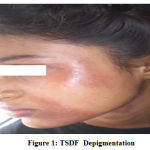 |
Figure 1: TSDF Depigmentation. |
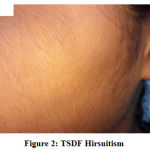 |
Figure 2: TSDF Hirsuitism. |
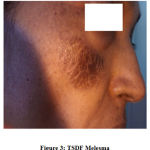 |
Figure 3 : TSDF –Melesma. |
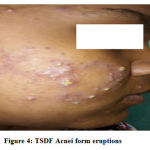 |
Figure 4 : TSDF–Acnei form eruptions. |
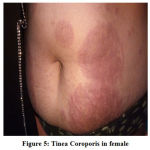 |
Figure 5: Tinea Coroporis in female. |
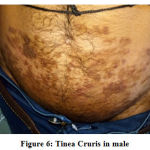 |
Figure 6: Tinea Cruris in male. |
Inference
Tinea (105 cases) was the commonest indication for which steroids were applied topically this is
Followed by cosmetic reason & acne vulgaris(Table III).
Table 3: Indications of offending topical steroid administration.
| Indication | No. of cases of topical steroid application | Percentage(%) |
| Tinea Cruris | 74 | 40.88 |
| Tinea Corporis | 25 | 13.81 |
| Tinea facie | 5 | 2.76 |
| Tinea pedis | 1 | 0.55 |
| Cosmetic Reason | 36 | 19.88 |
| Acne Vulgaris | 36 | 19.88 |
| Eczema & Pruritus | 4 | 2.20 |
Inference
Self medication is most common mode of topical steroid accessibility, while prescribed mode is least(Table IV).
Table 4: Mode of accessibility to Topical steroids-
| Mode of accessibility | No. of Cases | Percentage(%) |
| Self Medication | 84 | 46.40 |
| OTC drug use | 62 | 34.25 |
| Prescribed | 35 | 19.33 |
Inference
Betamethasone was most commonly applied topical steroid while cortisone was least commonly applied(Figure 7).
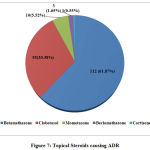 |
Figure 7: Topical Steroids causing ADR. |
Discussion
This study was done to know the extent of topical steroid abuse and subsequent adverse effects in terms of age group affected, manifestation of abuse, indication of steroid application, mode of accessibility and most common steroid abused topically. In this study age group most commonly affected belong to 21 to 30 years (41.98 %) followed by 11to 20 years (28.72%) this finding is similar to study conducted by Meena S et al.[5] and some other studies[6],[7],[8] this is because people in this age group is more likely accessible to self medication compared to elderly people and children.
In this study there were only two manifestation of topical steroid abuse firstly Tinea incognito (58%) , secondly TSDF (42%) ,Meena S et.al. also found Tinea incognito as the commonest adverse effect in their study[5]. TCs by suppressing the normal cutaneous immune response enhance fungal infections.[9]
TSDF or red face syndrome is a recently described entity characterized by plethora of symptoms caused by unsupervised misuse /abuse/overuse of TC of any potency on the face over an unspecified and/or prolonged period.[10]
In this study Tinea (58%) was the most common indication for which steroid was abused followed by cosmetic reason (19.88%) and acne vulgaris (19.88%).This finding is similar to study conducted by Meena S et.al.[5]
Self medication (46.40%) was most common mode of steroid accessibility followed by over the counter (OTC) drug use (34.25%) while prescribed mode (19.33%) was least common. This finding is similar to other studies[6],[7],[8] .
In this study betamethasone (61.87%) was most commonly abused steroid this finding is different from study conducted by Meena S et.al.[5] in which clobetasol was most commonly abused but similar to some other studies[7],[8] .
Conclusion
As revealed by this study young people are more vulnerable to topical steroid abuse , so our health education program must be targeted to these people. There is a need to strengthen the health regulatory policies and strict control over the OTC drug sale. People must be awared regarding harmful effects of unguided use of topical steroid, they should use steroid only when prescribed by registered practitioner or dermatologist.
References
- Ljubojeviae S, Basta JA, Lipozeneiae J. Steroid dermatitis resembling rosacea: aetiopathogenesis and treatment. J Eur Acad Dermatol Venerol. 2002;16:121-6.
CrossRef - Yasmeen J Bhat, Sheikh Manzoor, Seema Qayoom. Steroid-induced rosacea: a clinical study of 200 patients. Indian Journal of Dermatology. 2011;56(1).
CrossRef - Vivek Kumar Dey. Misuse of topical corticosteroids: A clinical study of adverse effects. Indian Dermatology. 2014;5.
CrossRef - Hengge UR, Ruzicka T, Schwartz RA, Cork MJ. Adverse effects of topical glucocorticosteroids. J Am Acad Dermatol. 2006;54:1-15.
CrossRef - Meena S, Gupta LK, Khare AK, Balai M, Mittal A, Mehta S, Bhatri G. Topical corticosteroids abuse: A clinical study of cutaneous adverse effects. Indian J Dermatol 2017;62:675
CrossRef - Al-Dhalimi MA, Aljawahiry N. Misuse of topical corticosteroids: A clinical study in an Iraqi hospital.East Mediterr Health J 2006;12:847-52.
- Dey VK. Misuse of topical corticosteroids: A clinical study of adverse effects. Indian Dermatol Online J 2014;5:436-40.
CrossRef - Rathod PR, Shankar R, Sawant A. Clinical study of topical corticosteroids misuse. Int J Recent Trends Sci Technol 2015;15:322-3.
- Verma S, Madhu R. The Great Indian epidemic of superficial dermatophytosis: An appraisal. Indian J Dermatol 2017;62:227-36.
- Lahiri K, Coondoo A. Topical steroid damaged/dependent face (TSDF): An entity of cutaneous pharmacodependence. Indian J Dermatol 2016;61:265-72.
CrossRef








